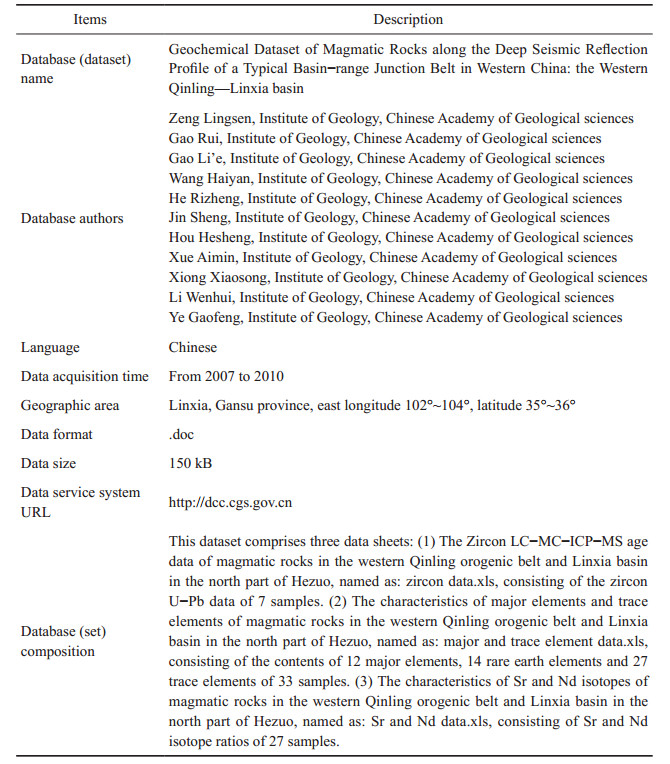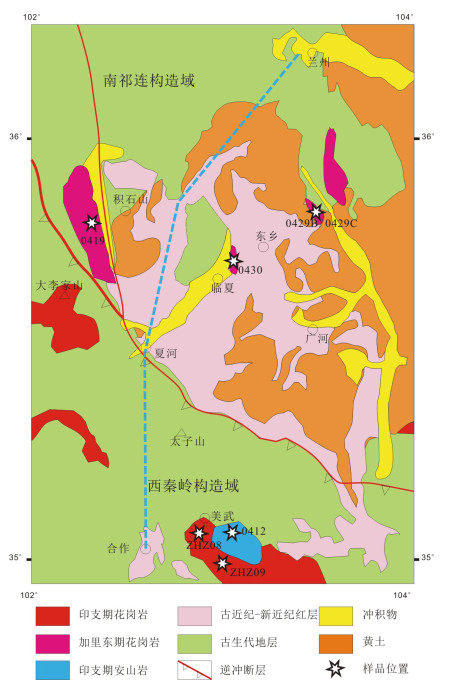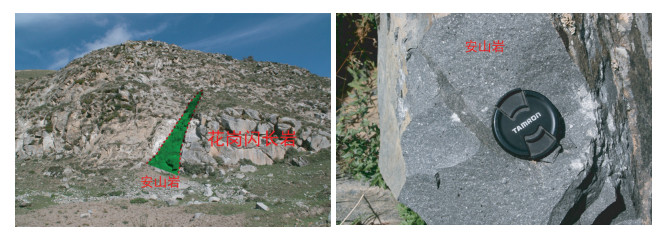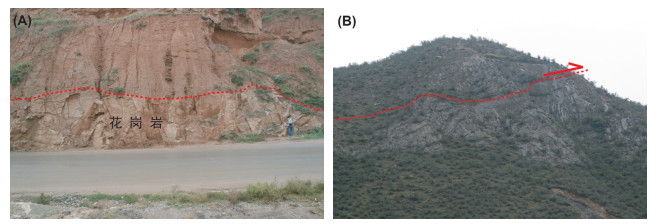Geochemical Dataset of Magmatic Rocks along the Deep Seismic Reflection Profile of a Typical Basin-range Junction Belt in Western China: the Western Qinling-Linxia Basin
-
摘要:
西秦岭造山带位于青藏高原的东北缘,其岩石圈结构与变化记录着高原向东北发展演化的深部过程信息。西秦岭造山带也是中国资源开发的远景区,特别是随着全球石油的紧缺,我国石油地质界加快了新区勘探,西秦岭造山带与其两侧盆地被列为中国油气勘探评价值得重视和重新认识的战略选区之一。在野外观测的基础上,对跨越西秦岭和位于南祁连的临夏盆地的深地震反射剖面沿线的重要地质体进行了系统采样,开展了锆石U-Pb地质年代学、全岩元素和同位素(Sr和Nd)组成的测试工作。西秦岭—临夏盆地深地震反射剖面沿线重要岩浆岩岩石地球化学测试数据集中共包含3个数据表,分别为合作北部西秦岭造山带和临夏盆地内岩浆岩的锆石LC-MC-ICP-MS定年数据(共计7个测试样品、145个测试点,测试精度为(2σ)均为2%)、合作北部西秦岭造山带和临夏盆地内岩浆岩的主量元素和微量元素特征(共计33个测试样品,每个样品有69个测试项,含量大于10×10-6的元素的测试精度为5%,而小于10×10-6的元素精度为10%)、合作北部西秦岭造山带和临夏盆地内岩浆岩的Sr和Nd同位素特征(共计27个测试样品,Sr和Nd同位素的测试精度分别为±0.000010(n=18),和±0.000011(n=18))。这些数据为厘定不同岩浆岩的形成年代和地球化学性质,从而更好地解译地震反射剖面揭示的深部地质构造所代表的构造意义。
Abstract:The western Qinling orogenic belt is located in the northeastern margin of the QinghaiXizang Plateau, and its lithosphere structure and changes record the deep process information of the plateau to the northeast. The western Qinling orogenic belt is also a prospect for resource development in China. Especially because of the shortage of global oil, China's petroleum geology has accelerated the exploration in new areas. The western Qinling orogenic belt and both its basins are listed as one of the most worthy of oil and gas exploration strategic constituencies. On the basis of field observation, important geological bodies along the deep seismic reflection profiles across the West Qinling Mountains and the Linxia basin in southern Qilian were sampled. Zircon U-Pb geology chronology, whole rock elements and isotope (Sr and Nd) composition of the test work resulted in a dataset containing three data tables, including the zircons LA-MC-ICP-MS of magmatic rocks from the western Qinling orogenic belt and the Linxia basin (a total of 7 test samples, 145 test points, the test accuracy of (2σ) are 2%), major and trace elements of investigated magmatic rocks (a total of 33 test samples, each sample with 69 test items, the content of more than 10×10-6 elements with test accuracy of 5%, and less than 10×10-6 element accuracy of 10%), and whole-rock Sr and Nd isotopic data for magmatic rocks(Sr±0.000010 (n=18) and Nd±0.000011 (n=18), respectively, in 27 test samples from the western Qinling orogenic belt and the Linxia basin). These data are used to determine the ages and geochemical properties of different magmatic rocks, in order to better explain the tectonic significance represented by the deep geological structure revealed by the seismic reflection profile.
-
Key words:
- basin-range junction belt /
- west Qinling-Linxia basin /
- seismic reflection /
- lithogeochemistry /
- dataset /
-

-
表 1 数据库(集)元数据简表

Table 1. Metadata table of dataset(s)

-
方小敏, 李吉均, 朱俊杰, 陈怀录, 曹继秀.1997.甘肃临夏盆地新生代地层绝对年代测定与划分[J].科学通报, 42(14):1457-1471. doi: 10.3321/j.issn:0023-074X.1997.14.001
甘肃省区调队.1965.1:20万中华人民共和国地质图说明书(临夏幅)[M].北京:地质出版社.
李吉钧, 方小敏, 朱俊杰. 1995. 临夏盆地新生代地层古地磁年代与模式序列[C]//青藏高原形成演化、环境变迁与生态系统研究学术论文年刊(1994). 北京: 科学出版社, 41-54.
Sun S S, McDonough W F. 1989. Chemical and Isotopic Systematics of Oceanic Basalts: Implications for Mantle Composition and Processes[M]. Geological Society, London, Special Publications, 42: 313-34.
http://ci.nii.ac.jp/naid/30036979244 喻学惠.1994.甘肃礼县-宕昌地区新生代钾质碱性超基性火山岩的特征及成因[J].特提斯地质, 18:114-129. http://www.cqvip.com/QK/98500A/199400/1005036566.html
喻学惠, 莫宣学, Martin F, 苏尚国, 赵欣.2001.甘肃西秦岭新生代钾霞橄黄长岩火山作用及其构造含义[J].岩石学报, 17(3):366-377. http://www.cnki.com.cn/Article/CJFDTOTAL-KXTB200523012.htm
郑德文, 张培震, 万景林, 李传友, 曹继秀.2003.青藏高原东北边缘晚新生代构造变形的时序——临夏盆地碎屑颗粒磷灰石裂变径迹记录[J].中国科学(D辑), 33(增刊):190-198. http://www.oalib.com/paper/4152997
Fang Xiaomin, Li Jijun, Zhu Junjie, Chen Huailu, Cao Jixiu.1997.Absolute age determination and division of Cenozoic strata in Linxia basin, Gansu Province[J].Chinese Science Bulletin, 42(14):1457-1471(in Chinese). https://www.sciencedirect.com/science/article/pii/S1367912012004336
The Field Team of Gansu Province.1965.1:200000 Map of the Geological Map of the People's Republic of China, Linxia[M].Beijing:Geological Publishing House (in Chinese).
Li Jijun, Fang Xiaomin, Zhu Junjie. 1995. Paleomagnetism and patterns of Cenozoic strata in Linxia basin[C]//Formation and Evolution of the Qinghai-Xizang Plateau, Environmental Change and Ecosystem Research (1994). Beijing: Science Press, 41-54(in Chinese).
Sun S S, McDonough W F. 1989. Chemical and Isotopic Systematics of Oceanic Basalts: Implications for Mantle Composition and Processes[M]. Geological Society, London, Special Publications, 42: 313-34.
http://ci.nii.ac.jp/naid/30036979244 Yu Xuehui, Mo Xuanxue, Martin F, Su Shangguo, Zhao Xin.2001.Cenozoic kamafugite volcanism and tectonic meaning in west Qinling area, Gansu province[J].Acta Petrologica Sinica, 17(3):366-377(in Chinese with English abstract). https://www.researchgate.net/publication/285861658_Cenozoic_kamafugite_volcanism_and_tectonics_in_West_Qinling_area_Gansu_province
Yu Xuehui.1994.Cenozoic potassic alkaline ultrabasic volcanic rocks and its genesis in Lixian-Dangchang area, Gansu Province[J].Tethyan Geology, 18:114-129(in Chinese). https://link.springer.com/article/10.1007/s11430-016-9030-2
Zheng Dewen, Zhang Peizhen, Wan Jinglin, Li Chuanyou, Cao Jixiu.2003.Timing of Late Cenozoic tectonic deformation in the northeastern margin of the Qinghai-Xizang Plateau-Apricot fission track record of detrital particles in Linxia basin[J].Science in China (Series D), 33(sup.):190-198(in Chinese).
-




 下载:
下载:


